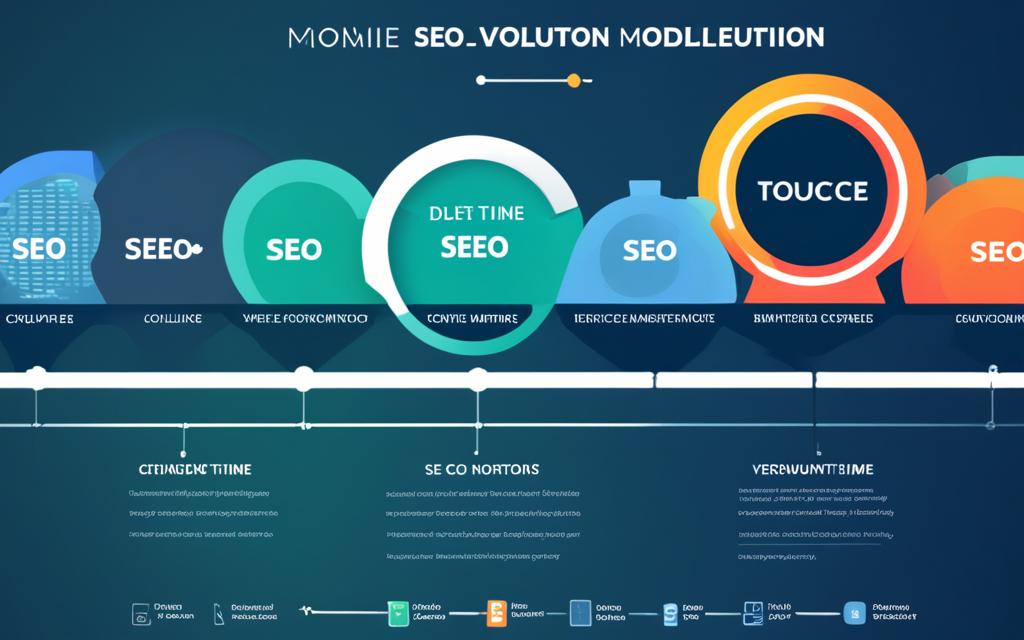Welcome to the world of SEO! In this section, we will dive into the essential SEO best practices that can significantly enhance your website’s online presence. By incorporating these strategies, you will be able to optimize your content, create a superior user experience, and ultimately improve your search engine rankings.
Implementing effective SEO techniques is crucial in today’s digital landscape. With millions of websites competing for attention, it is essential to stand out and make sure your target audience can find you easily. By following these SEO best practices, you will be one step closer to achieving your online goals.
Throughout this article, we will explore various aspects of SEO, including keyword research strategies, on-page optimization techniques, content creation tips, mobile optimization, technical essentials, link building techniques, user experience optimization, monitoring and analytics, local SEO tips, and common SEO mistakes to avoid.
We will provide you with valuable insights, practical tips, and actionable advice to help you navigate the complex world of SEO and achieve sustainable online success. So let’s get started and maximize your website’s visibility, traffic, and conversions!
Throughout this article, we will explore various aspects of SEO, including keyword research strategies, on-page optimization techniques, content creation tips, mobile optimization, technical essentials, link building techniques, user experience optimization, monitoring and analytics, local SEO tips, and common SEO mistakes to avoid.
Keyword Research Strategies
Effective keyword research is crucial for SEO success. By understanding the keywords that your target audience is using to search for information or products related to your business, you can optimize your website to rank higher in search engine results. In this section, we will explore various keyword research strategies to help you identify the most relevant and high-performing keywords for your website.
1. Brainstorming: Start by brainstorming a list of keywords and phrases that are relevant to your business. Think from the perspective of your target audience and consider the terms they are likely to use when searching online. This initial list will provide a foundation for further research.
2. Competitor Analysis: Analyze the keywords your competitors are targeting. Tools like SEMrush and Ahrefs can help you identify which keywords your competitors are ranking for and give you insights into their SEO strategy. This research will allow you to identify gaps and opportunities to target keywords that your competitors may have overlooked.
3. Keyword Research Tools: Utilize keyword research tools to gather insights and data on search volume, competition, and potential keyword variations. Tools like Google Keyword Planner, Moz Keyword Explorer, and KeywordTool.io can provide valuable information to refine your keyword list and discover new keyword opportunities.
4. Long-tail Keywords: Long-tail keywords are longer, more specific keyword phrases that typically have lower search volume but higher conversion rates. Incorporating long-tail keywords into your SEO strategy can help you target a more specific audience and improve your chances of ranking higher for niche searches.
5. User Intent: Consider the intent behind the keywords your target audience is using. Are they looking for information, products, or solutions? Understanding user intent can help you optimize your website content to align with their needs and provide them with relevant information or solutions.
6. Analyzing Search Trends: Stay up-to-date with the latest trends and changes in your industry. Use tools like Google Trends to identify popular search topics and adjust your keyword strategy accordingly. By aligning your content with current trends, you can attract more organic traffic.
By incorporating these keyword research strategies into your SEO efforts, you can identify the most relevant keywords and optimize your website to drive targeted traffic and improve your online visibility. Remember, effective keyword research is an ongoing process that requires regular monitoring and adjustment to stay ahead of the competition.
On-Page Optimization
On-page optimization is a crucial aspect of SEO that directly influences your website’s visibility on search engine result pages (SERPs). By optimizing various elements on your web pages, you can improve your chances of ranking higher and attracting organic traffic. Let’s explore the best practices for effective on-page optimization.
1. Meta Tags: Meta tags provide search engines with important information about your webpage. Focus on writing unique and compelling meta titles and descriptions that include relevant keywords. This helps search engines understand the content and context of your page, increasing its chances of appearing in relevant search queries.
2. Headings: Properly structured headings using HTML (H1, H2, H3, etc.) make it easier for both users and search engines to comprehend your content. Include your target keywords naturally within the headings to signal their importance.
3. URL Structure: Create clean and descriptive URLs that reflect the content of your page. Avoid using long and irrelevant strings of numbers or characters. Instead, use hyphens to separate words and keep URLs concise.
4. Keyword Placement: Strategically incorporate your target keywords within the content, especially in the first paragraph and subheadings. However, make sure to prioritize user experience and avoid keyword stuffing, as search engines penalize excessive use of keywords.
5. Image Optimization: Images not only enhance the visual appeal of your website but can also contribute to SEO. Use descriptive file names and include alt tags that clearly describe the image using relevant keywords. This helps search engines better understand the content and context of your images.
6. Internal Linking: Link to relevant pages within your website to provide additional value to users and improve the overall SEO of your site. Internal links help search engines discover and navigate through your website, increasing its overall authority and credibility.
7. User Experience (UX): Optimize your website for a seamless user experience. Ensure fast page load times, easy navigation, mobile responsiveness, and engaging content. A positive user experience not only encourages visitors to spend more time on your site but also signals its quality to search engines.
8. High-Quality Content: Content is king in SEO. Create informative, engaging, and original content that provides value to your target audience. Incorporate relevant keywords naturally, but focus on delivering valuable and well-researched information that satisfies user intent.
“On-page optimization is like the foundation of your SEO efforts. By implementing the best practices, you can set your website up for success in search engine rankings.”
By implementing these on-page optimization techniques, you can significantly improve your website’s visibility in search engine results. Remember to regularly monitor and analyze your performance using tools like Google Analytics to identify areas for improvement and adjust your strategy accordingly.
Quality Content Creation
Content is the foundation of your online presence. To rank higher in search engine results and engage your audience, you need to focus on creating quality content. In this section, we will discuss strategies to help you craft compelling and informative pieces that satisfy both search engines and users.
1. Keyword Integration: Incorporating relevant keywords naturally into your content is crucial for SEO. Conduct thorough keyword research to identify the terms and phrases your target audience is searching for. Integrate these keywords strategically throughout your content, including in headings, subheadings, and meta tags.
2. Valuable Information: Provide your audience with valuable and useful information. Answer their questions, address their pain points, and offer practical solutions. Aim for in-depth content that goes beyond surface-level information and provides comprehensive insights.
3. Enhanced Readability: Make your content easy to read and understand. Use short paragraphs, subheadings, bullet points, and numbered lists to improve readability. Break up the text with relevant images, diagrams, and examples to make it visually appealing and engaging.
4. Engaging Headlines: Capture your audience’s attention with compelling headlines that provide a clear benefit or promise. Use power words, create curiosity, and spark interest to entice readers to click and engage with your content.
Remember, quality content creation goes hand in hand with a strong content marketing strategy. Regularly publish fresh, original, and relevant content to establish yourself as an authoritative source in your industry. By consistently delivering value to your audience, you’ll increase your chances of attracting organic traffic and building a loyal following.
In the next section, we will discuss the importance of mobile optimization and how it can impact your website’s SEO performance.
Mobile Optimization
With the increasing use of smartphones, mobile optimization is critical for SEO. In today’s digital landscape, more and more people are accessing websites through their mobile devices. As a result, search engines prioritize mobile-friendly websites, making it essential for businesses to optimize their sites for mobile users.
When it comes to mobile optimization, there are several best practices that you should consider. The first is responsive design. Responsive design ensures that your website adapts to different screen sizes and resolutions, providing an optimal viewing experience for mobile users. It also helps with improving usability and reducing bounce rates, ultimately boosting your SEO rankings.
Page speed is another crucial factor in mobile optimization. Mobile users expect fast-loading pages, and search engines take page speed into account when ranking websites. To improve your page speed, consider optimizing images, minifying CSS and JavaScript files, and leveraging caching techniques.
In addition to responsive design and page speed, user-friendly navigation is vital for mobile optimization. Mobile users often have limited screen space and interact with websites through touchscreens, so it’s essential to have clear and accessible navigation menus. Simplify your menu structure, use drop-down menus when appropriate, and ensure that all buttons and links are easy to tap.
By implementing these mobile optimization strategies, you can improve your website’s performance and provide a seamless experience for mobile users. Remember, mobile optimization is not only beneficial for SEO but also for user satisfaction and conversion rates. So, make sure your website is optimized for mobile devices to stay ahead in the digital landscape.
Technical SEO Essentials
When it comes to maximizing your website’s search engine performance, technical SEO is essential. It lays the foundation for better visibility and rankings in search results. In this section, we will delve into key technical aspects that you need to focus on to optimize your website effectively.
Crawlability
One of the fundamental aspects of technical SEO is ensuring that search engines can crawl and index your website easily. This involves optimizing your robots.txt file, managing your website’s XML sitemap, and resolving any crawl errors that may hinder search engine bots from accessing your content.
Site Structure
The structure of your website plays a crucial role in how search engines understand and navigate your content. A well-organized site structure improves both user experience and search engine visibility. Consider organizing your content into relevant categories and subcategories, implementing breadcrumb navigation, and using internal linking strategically.
XML Sitemaps
An XML sitemap is a file that helps search engines discover and understand the structure of your website. It lists all the important pages on your site and provides additional information such as the last modified date and priority. Creating and submitting an XML sitemap ensures that search engines can crawl and index your pages more efficiently.
Schema Markup
Schema markup is structured data that you can add to your website’s HTML, providing search engines with additional information and context about your content. This helps search engines display rich snippets in search results, providing users with more relevant and detailed information. Implementing schema markup can enhance your visibility and click-through rates.
Page Load Speed
Page load speed directly impacts user experience and search engine rankings. Optimizing your website’s performance by minimizing server response time, compressing images, and enabling browser caching can improve page load speed. Faster loading pages not only please users but also help search engines crawl and index your pages more efficiently.
Mobile-Friendliness
In today’s mobile-first digital landscape, having a mobile-friendly website is crucial for SEO. A responsive website design adapts seamlessly to different screen sizes, providing an optimal user experience on both desktop and mobile devices. Search engines prioritize mobile-friendly websites, and not having one can negatively impact your rankings.
By paying attention to these technical SEO essentials, you set a strong foundation for better search engine visibility and improved user experience. Remember to regularly monitor and optimize these aspects to ensure your website remains competitive in the ever-evolving SEO landscape.
Link Building Techniques
Building high-quality backlinks is an essential component of any successful SEO strategy. By establishing a network of reputable websites linking to your site, you can significantly improve your website’s authority, increase organic traffic, and enhance your online visibility. In this section, we will explore effective link building techniques that can help you achieve these goals.
1. Guest Blogging
Guest blogging involves writing content for other websites within your industry. By contributing valuable and informative articles, you not only establish yourself as an expert but also have the opportunity to include backlinks to your own website. Make sure to target authoritative and relevant websites for maximum impact.
2. Broken Link Building
Broken link building is all about finding broken links on high-ranking websites and offering to replace them with relevant content from your site. By providing valuable resources, you not only help website owners fix broken links but also gain authoritative backlinks in return.
3. Influencer Outreach
Collaborating with influencers relevant to your industry can be an effective way to build links and gain exposure. Whether it’s through product reviews, sponsored content, or social media mentions, influencer outreach can help you reach a wider audience and generate valuable backlinks.
4. Content Creation and Promotion
Creating high-quality content that is valuable and shareable can naturally attract backlinks from other websites. By developing informative blog posts, infographics, videos, or interactive tools, you can encourage others to link to your content. Promoting your content through social media and email marketing can further enhance its reach and visibility.
5. Internal Link Building
Internal link building involves connecting relevant pages within your website through hyperlinks. By strategically linking related content, you can improve user experience, help search engines index your site, and distribute link equity throughout your website.
“Link building is like adding roads and tunnels to your website. It helps search engines navigate and discover valuable content, leading to improved rankings and increased organic traffic.”
Implementing effective link building techniques is crucial for long-term SEO success. By incorporating a combination of guest blogging, broken link building, influencer outreach, content creation and promotion, and internal link building, you can enhance your website’s authority, improve search engine rankings, and attract targeted organic traffic.
User Experience and SEO
When it comes to SEO, optimizing your website for user experience (UX) is just as important as focusing on keywords and backend technicalities. User experience directly affects how visitors interact with your site and can have a significant impact on your search engine rankings. In this section, we will explore the key elements of user experience and how it relates to SEO.
Usability and Navigation
A crucial aspect of user experience is the ease of navigating and using your website. Users should be able to find the information they need quickly and intuitively. A well-designed and user-friendly navigation menu, clear links, and logical page hierarchy can make a big difference. Incorporate descriptive page titles and headings to guide users and search engines through your content.
Furthermore, ensure that your website is responsive and accessible across different devices and screen sizes. Mobile optimization is not only important for user experience but also a ranking factor in search engines’ algorithms. A responsive design that adapts to various screen resolutions will enhance user experience and improve SEO performance.
User Engagement
Engaging your users is key to keeping them on your site for longer periods, reducing bounce rates, and improving SEO. User engagement can be enhanced through various methods, such as compelling and informative content, engaging visuals, interactive features, and a well-organized layout.
Consider integrating multimedia elements like images, videos, and infographics to make your content more visually appealing and engaging. Use relevant and descriptive alt tags for your images to provide context for search engines.
“Good SEO work only gets better over time. It’s only search engine tricks that need to keep changing when the ranking algorithms change.” – Jill Whalen
Page Load Speed
Page load speed is a critical factor both for user experience and SEO. Users expect websites to load quickly, and search engines penalize slow-loading sites with lower rankings. Optimize your website’s performance by minimizing the file sizes of images, minimizing redirects, leveraging browser caching, and using a content delivery network (CDN) to serve your content more efficiently.
Ensuring Accessibility
An often overlooked aspect of user experience is accessibility. Your website should be designed to be accessible to all users, including those with disabilities. By incorporating accessibility features such as alt tags for images, descriptive link text, and keyboard navigation, you can provide a better user experience for all visitors to your site.
Summary
Optimizing your website for user experience not only enhances your SEO performance but also ensures that visitors have a positive impression of your brand. By focusing on usability, navigation, user engagement, page load speed, and accessibility, you can create a seamless and enjoyable experience for your audience, leading to higher rankings and increased conversion rates.
Monitoring and Analytics
Monitoring and analyzing your website’s data is crucial for understanding its performance and making informed optimizations. By tracking key metrics and utilizing analytics tools, you can gain valuable insights into your SEO efforts and identify areas for improvement. Let’s explore some best practices for monitoring and analyzing your website’s performance.
Tracking Key Metrics
When it comes to monitoring your website’s performance, it’s essential to focus on key metrics that provide valuable insights into your SEO efforts. These metrics include:
- Organic traffic: Measure the number of visitors coming to your site through search engines.
- Keyword rankings: Keep track of your website’s rankings for targeted keywords and monitor changes over time.
- Conversion rate: Analyze how well your website converts visitors into leads or customers.
- Bounce rate: Determine the percentage of visitors who leave your site after viewing only one page.
- Page load speed: Monitor the time it takes for your web pages to load and optimize for faster speeds.
By regularly monitoring these metrics, you can identify trends, detect issues, and make data-driven decisions to improve your website’s performance.
Utilizing Analytics Tools
Analytics tools play a vital role in gathering and analyzing data to help you understand your website’s performance. Here are some popular analytics tools you can use:
| Analytics Tool | Description |
|---|---|
| Google Analytics | A comprehensive free tool that provides valuable insights into your website’s traffic, user behavior, and conversions. |
| Ahrefs | A powerful SEO tool that offers in-depth analysis of your website’s backlinks, keyword rankings, and competitor research. |
| Moz Pro | Another popular SEO toolset that includes features like rank tracking, site audits, and keyword research to enhance your SEO strategy. |
These tools provide extensive data and features to help you track and analyze your website’s performance effectively. Choose the one that best suits your needs and helps you make informed decisions to improve your SEO efforts.
Remember, monitoring and analytics are ongoing processes. Continuously track your metrics, analyze the data, and make necessary optimizations to stay on top of your SEO game.
Visual representation can also be beneficial when analyzing data. Use charts, graphs, and visualizations to interpret and present your website’s performance metrics effectively.
Local SEO Tips
Optimizing your website for local searches can greatly impact your online visibility and attract relevant customers in your target geographic locations. Here are some essential local SEO tips to boost your website’s performance:
- Claim and optimize your Google My Business listing: Create or claim your business profile on Google My Business to ensure accurate information is displayed in local searches. Provide comprehensive details about your business, including contact information, opening hours, and photos, to enhance your online presence.
- Target local keywords: Incorporate location-specific keywords naturally throughout your website content, meta titles, and descriptions. This will help search engines understand your relevance to local queries and improve your visibility in local search results.
- Optimize your website for mobile: With the increasing use of mobile devices, it’s crucial to have a mobile-friendly website to deliver a seamless user experience. Ensure your website is responsive, loads quickly, and has clear navigation to cater to mobile users.
- Obtain local backlinks: Building high-quality backlinks from local websites and directories can boost your website’s authority and increase visibility in local search results. Seek opportunities for guest posting, collaborations, or local sponsorships to enhance your local SEO efforts.
- Encourage customer reviews: Positive customer reviews play a crucial role in building trust and attracting new customers. Encourage satisfied customers to leave reviews on platforms like Google My Business, Yelp, or industry-specific review sites.
- Utilize local structured data: Implementing structured data markup on your website helps search engines understand your business details, such as address, phone number, and business hours. This markup can improve the display of your information in local search results.
By implementing these local SEO tips, you can enhance your website’s visibility in local searches and connect with potential customers who are searching for products or services in your area.
| Benefits of Local SEO | Challenges of Local SEO |
|---|---|
| Improved local visibility | Intense competition in local markets |
| Increased targeted website traffic | Constantly changing local search algorithms |
| Higher conversion rates | Managing and monitoring local listings |
| Enhanced online reputation | Managing customer reviews and ratings |
Common SEO Mistakes to Avoid
When it comes to optimizing your website for search engines, avoiding common SEO mistakes is crucial. These errors can hinder your website’s rankings and prevent you from reaching your target audience effectively. By understanding and rectifying these mistakes, you can improve your website’s visibility and drive more organic traffic.
Lack of Keyword Research
One of the most frequent SEO mistakes is neglecting proper keyword research. Keywords are the foundation of SEO and play a significant role in determining your website’s search engine rankings. Without thorough keyword research, you risk optimizing your website for terms that have low search volume or high competition. Use keyword research tools to identify relevant keywords that align with your content and target audience.
Poor On-Page Optimization
On-page optimization is vital for improving your website’s visibility in search results. However, many websites fail to optimize their page titles, meta descriptions, headers, and image alt tags. Neglecting these critical elements can result in missed opportunities to rank higher in search engine results pages (SERPs). Take the time to optimize each page of your website with relevant keywords and compelling meta tags.
Thin or Duplicate Content
Having thin or duplicate content on your website can negatively impact your SEO efforts. Search engines prioritize websites that provide valuable and unique content to users. Thin content refers to pages with insufficient information and relevance, while duplicate content refers to identical or similar content existing on multiple pages. Ensure that each page of your website offers valuable and original content to enhance its visibility and credibility.
Broken or Non-Optimized Links
Broken links can harm the user experience and affect your website’s SEO. Search engines penalize websites with broken or non-optimized links, as they hinder the crawler’s ability to navigate and index your website effectively. Regularly check your website for broken links and ensure that all internal and external links are correctly optimized and functioning.
Ignoring Mobile Optimization
In today’s mobile-first world, ignoring mobile optimization is a grave mistake. Your website must be responsive and user-friendly across all devices, including smartphones and tablets. Neglecting mobile optimization not only leads to a poor user experience but also hurts your search engine rankings. Optimize your website for mobile devices to ensure a seamless browsing experience for your visitors.
Overlooking Technical SEO
Technical SEO involves optimizing the technical aspects of your website to improve its search visibility. Neglecting technical SEO can result in crawl errors, slow website speed, poor indexing, and other issues that negatively impact your website’s performance. Pay attention to technical elements such as website speed, XML sitemaps, robots.txt files, and structured data to maximize your website’s visibility in search results.
Inadequate Backlink Strategy
Backlinks play a crucial role in SEO, but an inadequate backlink strategy can harm your website’s rankings. Focus on quality over quantity when building backlinks and avoid spammy or low-quality sources. Engage in ethical link-building practices such as guest posting, influencer collaborations, and earning backlinks from reputable websites in your industry.
Failure to Analyze and Adapt
SEO is an ongoing process that requires continuous analysis and adaptation. Many websites make the mistake of neglecting analytics and failing to track the performance of their SEO efforts. Regularly monitor your website’s analytics to gain insights into user behavior, traffic sources, and keyword performance. Use this data to identify areas for improvement and make necessary adjustments to your SEO strategies.
Not Optimizing for Local Search
If your business relies on local customers, not optimizing for local search can be a significant setback. Local SEO involves optimizing your website and online presence to attract local customers searching for products or services near their location. Ensure that your website includes location-specific keywords, accurate contact information, and listings on local directories to enhance your visibility for local searches.
Avoiding these common SEO mistakes will help you build a strong foundation for your website’s search engine optimization. By focusing on best practices, continuously improving your strategies, and staying up to date with the latest SEO trends, you can ensure that your website ranks higher in search results and attracts relevant organic traffic.
Conclusion
In conclusion, implementing these SEO best practices will help you enhance your online presence and climb the search engine rankings. By optimizing your content, improving user experience, and staying updated with the latest SEO techniques, you can achieve long-term organic growth and attract more targeted traffic to your website.







